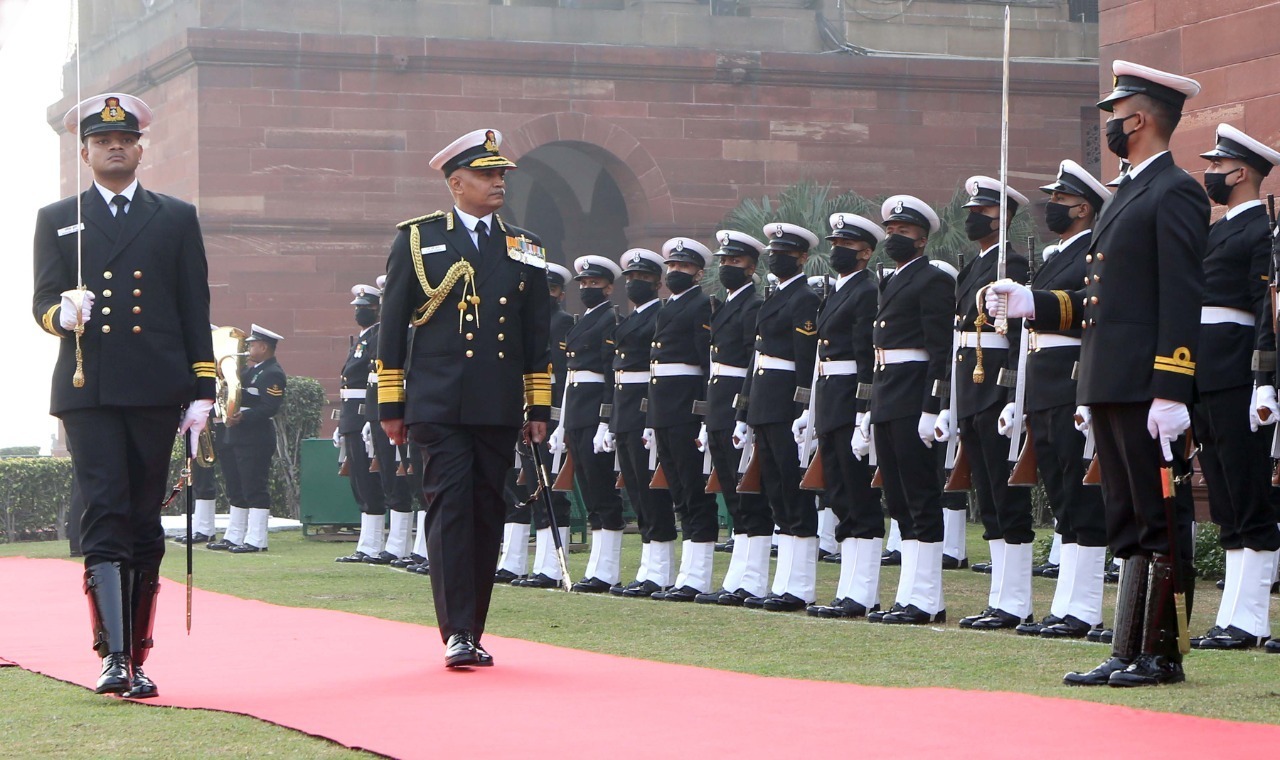India’s Chief of the Naval Staff, Admiral R Harikumar, is very clear that the country needs three aircraft carriers befitting a blue water navy.
“The Navy is seized of the security implications of the changing maritime/naval environment in the Indian Ocean Region (IOR) and maintains a constant and close watch on all developments, fine-tune our concept of operations, and formulate our capability perspective plans to cater to the developing threat.
Big Milestone For India! After UK, Indian Navy Tests Naval UAV From Indigenous Aircraft Carrier, Vikrant
“There is no doubt that the aircraft carrier is central to the Navy’s concept of operations, and the Navy would need three aircraft carriers to safeguard national maritime interests within our areas of interest against the backdrop of changing geo-politics in the Indian Ocean Region.
“The Carrier Battle Groups (CBGs) are undoubtedly the source of power projection and provide freedom of maneuver in the vast area of operations or interest. The three carriers would arm the Bharatiya Nausena (Indian Navy) with the required teeth to deter our potential adversaries from many misadventures and establish credible deterrence in our area of operations”, the Admiral said in an interview.
Asked how he describes the state of balance between the Indian Navy’s “capacity” and “capabilities” about the dimensions such as surface, sub-surface, aerospace, and cyber on the one hand and spheres such as “brown water” and “bluewater,” the Navy Chief said, “Navy’s military capability and force levels need to encompass a balanced Fleet, with a judicious mix of warships and aircraft of varying sizes and capabilities, possessing requisite reach and combat power in all dimensions.”
Accordingly, capabilities and capacities are both being enhanced in a balanced manner for undertaking missions in all dimensions of warfare. “For instance, the acquisition of warships (Carriers, LPD, Destroyers, Frigates, etc.) is being progressed together with the induction of submarines, Fighter aircraft, Reconnaissance Aircraft and UAVs, Multirole helicopters, etc., and space-based and information warfare Assets.”
Over the years, the Indian Navy has transformed into a technologically advanced Blue water force. The Indian Navy has made significant advancements in its sub-surface capabilities with the induction of Scorpene class submarines. These would be augmented in due course with additional submarines.
“The Navy has pioneered space-based communication amongst the three armed forces. We have also developed requisite in-house capability to address challenges in the cyber domain suitably.”
The Indian Navy is also committed to developing at least 75 technologies/products as part of ‘Azadi Ka Amrit Mahotsav’ (75 Years of India’s Independence), recently showcased during Swavlamban 2023. These technologies and products aim to realize the aim of ‘Aatmanirbhar Bharat’ (Self-Reliant India) and keep pace with emerging technologies.
“Suffice it to note that the state of balance between our capabilities and challenges of operations in blue/brown water is at par, and we are only getting better,” the Navy chief said.

Where does the Indian Navy stand concerning being as self-reliant as possible in line with Prime Minister Narendra Modi’s “Make in India” mission? The Admiral answered, “The Navy has nurtured indigenous shipbuilding programs since the 60s, when INS Ajay, the first indigenously built ship, was delivered by GRSE, Kolkata. Since then, the Navy has transformed from a ‘Buyers Navy’ into a ‘ Builders Navy,’ with an aircraft carrier, destroyers, stealth frigates, corvettes, submarines, and other war vessels being constructed in the country.”
He said the Defense Acquisition Procedure (DAP-20) derives its ethos and spirit from the clarion call of an Aatmanirbhar Bharat and Make in India, made by the Prime Minister. “With impetus on indigenous production of Naval equipment and platforms, Bharatiya Nausena (Indian Navy) is committed to becoming fully Aatmanirbhar by 2047. The Navy has been the pioneer Service towards indigenization and promoting the ‘Make in India’ initiative, with ‘Self Reliance in Defense Production’ being a top priority for the Service in the past six decades.”
This is evident from the fact that, to date, over 130 ships have been built and commissioned in India. 65% of the total expenditure has been focused on indigenous procurement in the last ten years. This year, 80% of our budget is towards domestic spending.
“Navy is committed to timely development and induction of successful indigenized products into the Service. During the ‘Swavlamban-2022’ seminar, 75 ‘Challenge Statements’ for Indian Industry, as part of an ambitious endeavor titled ‘SPRINT’ (Supporting Pole-Vaulting in R& D through iDEX, NIIO, and TDAC) were unveiled by the Prime Minister, aimed at developing at least 75 indigenous technologies/products for the Indian Navy.”
Subsequently, over 1,100 proposals were received in response to the Defense India Startup Challenge (DISC 7 SPRINT & Open Challenge 6), and 333 firms/MSMEs were shortlisted for presenting their solution to the High Power Screening Committee (HPSC).
The winners (118 firms/ innovators) of the DISC 7 SPRINT & PRIME challenges were declared on September 28 and October 10, 2022 respectively. Based on successful trials, AoN (Acceptance of Necessity) for 14 iDEX cases worth INR 1,342.33 crore have been accorded to date, of which three contracts worth INR 188.21 crore have been concluded.
“It is notable that today, out of 67 shipbuilding projects, 65 are being built by Indian Shipyards. We have achieved impressive milestones, with approximately 90% indigenization in the Float segment, 60% in the Move segment, and 50% in the Fight segment.
“The Government of India has taken commendable steps to promote self-reliance in recent years, and the Bharatiya Nausena has actively embraced various national Make-in-India initiatives. These include Make, Technology Development Fund (TDF) schemes, and Innovation for Defence Excellence (iDEX), which have played a pivotal role in transforming the Navy into a technologically advanced and self-reliant force,” the Admiral said.
“Currently, we are advancing more than 100 projects under the IDEX scheme – 25 under the TDF scheme, and 37 under the Make scheme. SWAVLAMBAN 2.0, the Indian Navy’s indigenization plan, was unveiled by the Defense Minister on October 4, 2023, to act as a comprehensive reference document of all Indigenisation requirements of the Navy.”
On the question of whether, as the principal organization to preserve and promote India’s maritime interests in general and in the Indo-Pacific in particular, the Indian Navy has the requisite power to meet the emerging geopolitical and geoeconomic challenges, the Admiral said, “No Commander would ever say that he has everything he needed, to fight every possible war, against every likely enemy, under every probable condition. Therefore, in absolute terms, it will always appear that the capabilities are insufficient.
“However, we are an aspirational growing power where military budgets will be balanced against developmental, social, and welfare-oriented imperatives. Therefore, the Navy looks at maximizing the budget allocation through detailed perspective plans that determine precisely what is needed, how much is required, and when.
“Moreover, these plans align with the broader maritime strategy being pursued. This ensures that we remain well-equipped to tackle the envisaged threats. Our endeavor is to make every rupee count for capital acquisition or revenue expenditure.
“Also, we have kept our focus on spending the full quota of the allocated budget – which, in turn, ensures that our budgetary projections match with our plans, and the impetus remains to materialize the objective on the ground into reality. This results in the timely acquisition of assets, weapons, sensors, and machinery and maintenance and upkeep of our existing inventory.
“The Sum Total of meticulous planning and prudent spending is that the Navy remains Combat Ready, Credible, Cohesive, and Future-Proof as the budget is translated into desired capabilities and capacities, guided by the vision of being a fully Aatma-Nirbhar Force by 2047.
“Having said that, I am confident that, as our Nation continues to maintain a positive trajectory of growth, the Services’ and the Navy’s share of the budget will also increase. We will always have, even if not plenty, sufficient capabilities to surmount any security challenge that our Nation may face.”
Has the Indian Navy learned lessons, if any, from the ongoing War in Ukraine? The Indian Navy replied, “We have been closely monitoring the situation in Ukraine. Regarding its impact on the sustenance of our platforms, we have identified dependencies of spares for the maintenance of our legacy platforms, and alternatives have been found in most cases.
“As far as lessons from the conflict are concerned, self-reliance in the defense sector has re-emerged as one of the important takeaways. We have accordingly intensified our efforts towards self-reliance and accorded greater impetus to indigenization.”
- Author and veteran journalist Prakash Nanda is Chairman of the Editorial Board – EurAsian Times and has commented on politics, foreign policy, and strategic affairs for nearly three decades. A former National Fellow of the Indian Council for Historical Research and recipient of the Seoul Peace Prize Scholarship, he is also a Distinguished Fellow at the Institute of Peace and Conflict Studies.
- CONTACT: prakash.nanda (at) hotmail.com
- Follow EurAsian Times on Google News




